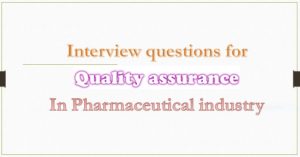Interview questions for quality assurance in pharmaceutical industry:
We have provided interview questions for quality assurance in pharmaceutical industry here. There is no specified differences between quality control and quality assurance from interview point of view. They are all interlinked. But we tried to prepare in separate posts and produced. This post is an extension to our previous interview questions for quality assurance in pharmaceutical industry. If you attending an interview, you have to all these questions and answers in these 4 posts. It helps you a lot to face interview well.
Interview questions for quality assurance in pharmaceutical industry are as follows.
Qa-What do you know about change control?
Changes which were made to materials or procedures or methods or equipment or software should be documented properly. These changes should approved, validated and able to traceable. Change control deals and makes sure all these changes.
Explain about Bracketing and Matrixing study designs in stability testing/
Ans) These are the study designs for stability testing. In a full study design, you have to test the samples of all the design factors at all time points. Bracketing and Matrixing are reduced study designs.
When multiple design factors involved in a study, these are the best alternatives to full study design. If you use these designs, you need not to test all the samples at all time points. These study designs mostly used when multiple design factors involved.
Bracketing: In this schedule, At all time points only extremes of certain study factor (like container fill & or container size or strength etc) samples tested. Bracketing supposes that tested extremes stability represents the intermediate levels stability of that study factor.
Matrixing: In this schedule, at a specific time point a selected subset of the total number of possible samples for all factor combinations would be tested. At a next or subsequent time point, all the factor combinations for another subset would be tested. Matrixing supposes that at a given time point, tested each subset stability represents the all the samples stability.
Before using this study designs, certain assumptions should be evaluated and justified.
NOEL: No Observed Effect Level
MACO: Maximum Allowable Carry Over
CAPA:
Corrective Action and Preventive action. It’s an important part of QMS (Quality Management System). Corrective actions planned to know the cause of the problems which were happened in the past and correct it. Preventive actions intended to prevent the problems that might happen in the future.
Explain about Out of Specification (OOS) results and Out Of Expectation (OOE) results?
Out Of Specification (OOS) results: Analysed test result falling out side the predefined acceptance range or criteria made by company documentation or official compendia.
Out Of Expectation (OOE) results: Although the Analysed test result falls within the specification, this result will falls out side the procedure expected variability.
Interview questions for quality assurance in pharmaceutical industry:
Stress Testing:
Also called as Forced degradation study, stress study. Forced degradation study intended to know the degradation products, it will helps us further to know the molecule intrinsic stability, degradation pathways establishment and to validate the molecule stability procedures. Stress testing conducted at the conditions which are more severe than the accelerated study conditions. For a formal stability program, stress testing not considered as a requirement. It is regulatory authority requirement.
What is the purpose/use(s) of stability testing?
Ans) Stability testing gives the confirmation as how the quality of study product changes with time.
It finds out the study product shelf life, recommended storage conditions as well as container closure system suability. Also gives assurance to the patient regarding stability of a drug product. Stability testing is a regulatory requirement also.
What are different types of stability studies along with its conditions?
Ans)
Long-term stability studies: Storage conditions 25+20C, 60+5% RH and Minimum Time period is 12 months
Intermediate stability studies: Storage conditions 30+20C, 60+5% RH and Minimum Time period is 6 months
Accelerated stability studies: Storage conditions40+20C, 75+5% RH and Minimum Time period is 6 months
Dead leg: Dead logs not allowed in water design systems. These are the stagnant areas with no water flow. It allows microbial contamination resulting the surface colonisation by forming biofilms. If a dead log present in any case, it should have particular pipe diameter and velocity. In general agreement in industry, dead log should not be more than the pipe diameter.
For e.g: If the pipe diameter is 5 cm , then dead log should not be more than 10cm.
Cleaning validation: It is a documented evidence involves the approved cleaning procedure for eliminating the process equipment contaminants. It means the process equipment ready and can be used safely for preparing the next product without any previous contaminants.
These contaminants may be chemical (previous product residues), microbial or Physical (Particulate matter) types. Different types of cleaning agents used in the cleaning validation like aqueous solvents (water, surfactants, acids or bases etc) and organic solvents.
Validation master plan (VMP):
It is a document describes the company’s validation strategy and approach for establishing the performance adequacy. VMP includes all the details and time scales regarding the validation work to be performed.
Process validation:
It provides a documented evidence assuring that a particular process produces a product with predetermined specifications and characteristics consistently.
Four types of process validation available.
Prospective validation: Conducted prior to process implementation to assuring that process is performs as intended on the basis of pre-planned plans.
Concurrent validation: Conducted during the product routine production.
Retrospective validation: Conducted on some products , those products which are already on commercial market. The intention is to establish the long term compliance of that product.
Re-validation: This is nothing but repetition of validation. Conducted to assuring that the changes/modifications done in equipment/process in according to the change control procedures. Those changes are not effecting the equipment/process and their produced products adversely.
This is the second post regarding Interview questions for quality assurance in pharmaceutical industry. You can view the previous post QA interview questions and answers.
Please share this post to your friends. If you have any other queries comment below.

